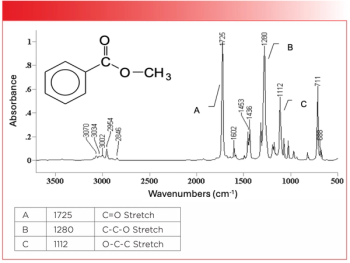
- June 2021
- Volume 36
- Issue 6
Fingerprinting of Mineral Medicine Natrii Sulfas by Fourier Transform Infrared Spectroscopy
We show how FT-IR may be used for quality control analysis of natrii sulfas, a transparent crystalline material used in natural medicine that primarily contains sodium sulfate decahydrate, crystallized from sulfate minerals.
Fourier transform infrared spectroscopy (FT-IR) was used to examine 20 batches of the mineral medicine natrii sulfas (NS) to establish its reference point and fingerprint it using the common peak patterns in the spectra of the samples. The correlation coefficient, corner cosine, and peak location averages were then used to evaluate the similarities between the spectra. The fingerprint was verified through cluster analysis of four batches of the mineral medicine. Finally, it was confirmed that fingerprinting is a facile, rapid, and accurate method for the quality control of NS.
Natrii sulfas (NS) is a transparent and lustrous crystal that primarily contains sodium sulfate decahydrate and is crystallized from sulfate minerals. NS is used as a medicine to help relax the bowels and soften stool; as a matter of clinical practice, it is also utilized for treating heat stagnation and abdominal distention and pain (1). Recent clinical reports suggested that topical NS can be used for curing intestinal obstruction (2) and phlebitis (3), and for other therapeutic applications. However, effective techniques for the quality control of NS are lacking in the existing literature. The traditional qualitative analysis method can only be used for identifying ions (4,5), which is inadequate because the method lacks specificity and cannot discern NS and medicines with similar compositions.
Modern instrumental methods including chromatography and spectroscopic techniques have been employed for the analysis and quality control of traditional Chinese medicine (TCM). Among the qualitative methods, infrared (IR) spectroscopy is the most common method for quality control of TCM (6,7). Compared to conventional chromatographic methods, IR spectroscopy facilitates rapid and lossless sample analysis with minimal sample preparation (8). Fourier transform infrared (FT-IR) spectroscopy is used to identify chemical substances based on the absorption of different frequencies of light that correspond to molecular vibration frequencies, thereby providing detailed information on the molecular structure and material composition. TCM is a complex branch of medicine, and FT-IR spectroscopy can provide its overall characteristics and macroscopic fingerprints (9–11). FT-IR spectroscopy is a simple, convenient, and rapid analysis technique; therefore, it is widely used for identifying TCM (12–17). In this study, it is proven that FT-IR finger- printing provides a convenient, rapid, and accurate method for the quality evaluation and control of NS.
Materials and Methods
Instruments and Materials
Potassium bromide was supplied by the Guangzhou Chemical Reagent Factory (Batch number: 20130601-1) and sodium sulfate was obtained from Sinopharm Chemical Reagent Co., Ltd. (Batch number: 20150212). FT-IR spectra were obtained using the Bruker Tensor 37 FT-IR spectrometer and were processed by an Opus acquisition system. Samples were dried using a WS70-1 infrared dryer, which were then pressed into tablets by a FW-5 pelletizer. An AY120 Shimadzu electronic balance and a BP211D Sartorius electronic balance were used for weighing the samples. Agate mortars were utilized to prepare the samples, and the 24 batches of samples (Table I) were gathered from pharmacies with the content of NS being determined by the 2015 Chinese Pharmacopoeia. The data was processed using the statistical package SPSS 20.
Determining the Content of Natrii Sulfas in 24 Batches of Samples
The process for determining the content of NS is a multistep one (1). A small amount of sample (0.4 g) was dissolved in distilled water (200 ml). Subsequently, 1 mL of hydrochloric acid was added to this solution, and it was stirred until it boiled. Simultaneously, a hot barium chloride test solution (20 mL) was added until no more precipitates were observed. Then, the reaction solution was heated on a water bath for 30 min and filtered through ashless filter paper after standing for 1 h. The precipitate was then washed with water until the washing liquid showed no trace of chlorides. Then, the precipitate was dried and then burned until a constant weight was obtained. The final weight was multiplied by 0.6086 to obtain the weight of sodium sulfate in the test sample. The data was processed using SPSS 20.
Preparation of Samples
To prepare the samples, potassium bromide was added to the sample (18,19). The ratio of potassium bromide to the sample was 1.5:1 (w:w). The sample was then milled and pressed to form a tablet (150 mg potassium bromide per tablet) for testing. This process was conducted at a temperature of 20 oC and at a relative humidity of 40%. The FT-IR spectra were obtained under the following conditions: scanning area = 400–4000 cm-1; resolution = 4 cm-1; diaphragm aperture = 6 mm; and scan repetitions = 16. Baseline correction, curve smoothing, and background correction were accomplished using Opus.
Establishing the Fingerprint
The 20 samples (M1–M20) established the average fingerprint of NS using the SPSS 20. The average fingerprint was obtained based on the wavenumber and transmittance of the common peaks in the spectra of the 20 batches of NS samples. In addition, the remaining four batches of samples (M21, B1, B2, S1) were selected as the validation set. Cluster analysis was utilized for examining the average fingerprint of NS.
Results and Discussion
The experimental conditions of IR measurement for NS were stringent because its water of crystallization can easily effloresce in the air (20). Therefore, to prevent the disappearance of the characteristic region of NS in its FT-IR spectrum, the diluent was mixed with NS twice prior to tableting.
Analyzing the FT-IR Spectra
NS is a type of sulfate mineral medicine containing inorganic sulfate radicals (18,21). The tetrahedral structure of inorganic sulfate radicals leads to three characteristic regions in the FT-IR spectrum, which include antisymmetric stretching vibration (1112 cm-1), asymmetric deformation vibration (637 cm-1 and 616 cm-1), and symmetric deformation vibration (478 cm-1 and 448 cm-1). Moreover, the wide absorption peak near 3400 cm-1 (3550 cm-1 to 3416 cm-1) corresponds to antisymmetric and symmetric stretching vibration of water molecule, and the sharp absorption peak (1637 cm-1 and 1618 cm-1) corresponds to deformation vibration.
Validation of the Analysis
The precision, repeatability, and stability tests were performed on the same sample (M15). The relative standard deviations (RSDs) of the wavenumber and transmittance represented by the common peaks in each precision test are all less than 0.23% and 1.63%, respectively. In the repeatability test, these values were less than 0.46% and 2.89%, respectively. In the 12-h stability test, these values were less than 0.36% and 2.72%, respectively. These results validate the accuracy and reliability of the analysis method.
Determination of Common Peaks in the FT-IR Spectra of Natrii Sulfas
Analyzing the FT-IR spectra of 20 batches of NS samples (M1–M20), the peaks are observed at (3551 ± 6) cm-1, (3476 ± 5) cm-1, (3416 ± 2) cm-1, (1626 ± 16) cm-1 (1118 ± 9) cm-1, (620 ± 19) cm-1, (477 ± 9) cm-1, and (422 ± 4) cm-1, as shown in Figure 1a. Therefore, the wavenumbers corresponding to the eight common peaks are 3551, 3476, 3416, 1626, 1118, 620, 477, and 422 cm-1 (Table II), which represent the characteristic peaks in the FT-IR fingerprint of NS (Figure 1b).
Evaluation of the Similarity of FT-IR Spectra of Natrii Sulfas
The correlation coefficient and the corner cosine of each sample were calculated by distance analysis with respect to the average transmittance of common peaks in the FT-IR spectra of 20 NS samples (22–24). The results are shown in Table III, which indicate that the correlation coefficient and corner cosine of each sample are above 0.8430 and 0.8881, respectively. The average value of correlation coefficient and corner cosine is above 0.8994.
The Verification of FT-IR Fingerprint of Natrii Sulfas
The FT-IR spectra of samples M21, B1, B2, and S1 were compared with the fingerprint of NS. The shape and position of peaks in FT-IR spectra of M21 are basically the same as that in FT-IR fingerprint of NS, but the FT-IR spectra of B1, B2 and S1 are completely different (Figure 2). Further, the similarity mean of correlation coefficient and corner cosine of B1, B2, and S1 samples is less than 0.8994. By contrast, the similarity mean of correlation coefficient and corner cosine of M21 is 0.9827 (Table IV). However, the spectrum of S1 is slightly similar to the fingerprint of NS, which may be attributed to the characteristics of sulfate mineral medicine. These four batches of samples belong to sulfate mineral medicine, which caused the appearance of characteristic peaks of inorganic sulfate groups at 1115 cm-1, 669 cm-1, 601 cm-1, 459 cm-1, and 426 cm-1. Based on the comparison of the spectra and the values of correlation coefficient, corner cosine, and their average, it can be concluded that B1, B2, and S1 are not NS. These results verify the reliability of the fingerprint of NS.
Clustering Analysis of the FT-IR Fingerprint
Considering the value of corner cosine from eight common peaks in the fingerprint of NS as a metric, we conducted the group clustering analysis using SPSS 20 (25–31). According to the experimental results, 24 tested samples can be roughly divided into two categories (Figure 3). The first category includes the M1–M21 samples, and the second one includes B1, B2, and S1. The consistency between the results of clustering analysis and verification based on similarity measurement confirm that the FT-IR fingerprinting facilitates rapid, precise, and accurate identification of NS.
Conclusion
We experimentally analyzed the sulfate mineral medicine NS by FT-IR spectroscopy combined with fingerprint technology. The FT-IR fingerprint of NS was established through spectrum processing techniques with pattern analysis and recognition. Eight common peaks were observed in the FT-IR fingerprint of NS at 3551 cm-1, 3476 cm-1, 3416 cm-1, 1626 cm-1, 1118 cm-1, 620 cm-1, 477 cm-1, and 422 cm-1. The spectral characteristics of minerals were primarily influenced by charge transitions or ion movements, which in turn affected the crystal structure. The differences in the chemical composition, mineral particles, surface morphology, incident light, reflected light, and the combined phase angle of the mineral medicine can be inferred (32). Although the infrared spectrum of the mineral medicine was mainly composed of sulfate group mode, the peak shape, peak number, and peak position in the infrared spectra of NS, alumen, and gypsum fibrosum were still different. This may be attributed to their different crystal structure, cation radius, and composition, which can even lead to peak splitting. Combined with cluster analysis, NS could be classified into a category, which was different from alumen and gypsum fibrosum.
Furthermore, the comparison between the spectra of each NS sample and the FT-IR fingerprint of NS revealed that the value of correlation coefficient, corner cosine, and their average are above 0.8430, 0.8881, and 0.8994. Overall, the FT-IR fingerprinting of NS facilitates a convenient, rapid, and accurate method for the quality evaluation and control of NS. Further, our results indicate the practicality of FT-IR technology in TCM research.
Acknowledgments
The authors gratefully appreciate the laboratory of the College of Chinese medicine in Guang Dong Pharmacy University to provide the instrumentation in support of our research.
Author Contributions
Wu Xiang-qin and Sun Fei are co-authors on this work. Wang Shu-mei and Liang Sheng-wang are the corresponding authors. All authors contributed to the experiments and approved the final manuscript.
Conflicts of Interest
The authors declare no conflicts of interest.
References
(1) Committee CP, Chinese Pharmacopoeia (China Medical Science Press, Beijing, China, 2015), pp. 127–128.
(2) S.Y. Liu, M. Bai, Y.L. Yang and M.S. Miao, J. Tradit. Chin. Med. 2, 58–61 (2012).
(3) B.B. Zhang, Q.Q. Nie, and H. Yu, New Chinese Medicine 51(8), 278–280 (2019). DOI: 10.13457/j.cnki.jncm.2019.08.084.
(4) X. Chang, SA Pharm J. 28(10), 60–61 (2016).
(5) L.F. Zheng, F. Sun, J. Meng, S. M. Wang and S. W. Liang, Zhongguo Shiyan Fangjixue Zazhi (Chinese Journal of Experimental Traditional Medical Formulae) 21(1), 35–37 (2015).
(6) S. Sun, J. Chen, Q. Zhou, G. Lu and K. Chan, Planta Med. 76(17), 1987–1996. (2010). DOI:10.1055/s-0030-1250520.
(7) C.W. Huck, Phytochemistry Letters 11, 384–393 (2015). DOI:10.1016/j.phytol.2014.10.026.
(8) T. Guo, W.H. Feng, X.Q. Liu, H.M. Gao, Z.M. Wang and L.L. Gao, J. Pharm. Biomed. Anal. 123, 16–23 (2016). DOI:10.1016/j.jpba.2015.11.021.
(9) B.L. Xu, X.W. Cui, S.Q. Sun, C.X. Wen, J.J. Wang, G.J. Zhang, J.J. Liu and H. Peng, Zhongguo Shiyan Fangjixue Zazhi 18(7), 142–145 (2012). DOI: CNKI: 11-3495/R.20120215.1251.003.
(10) M.L. Xu, H.F. Li, Q. Zhou, Q. Yin, S.Q. Sun, and X.Z. Wu, Guang Pu Xue Yu Guang Pu Fen Xi (Spectroscopy and Spectral Analysis) 30(3), 640–643 (2010).
(11) L. Xiang, J. Wang, G. Zhang, L. Rong, H. Wu, S. Sun, and L. Qu, J. Mol. Struct. 1124, 164–172 (2016). DOI:10.1016/j.molstruc.2016.02.058.
(12) L. Qu, J.B. Chen, Q. Zhou, G.J. Zhang, S.Q. Sun and Y. Z. Guo, J. Mol. Struct. 1124, 216–220 (2016). DOI:10.1016/j.molstruc.2016.01.056.
(13) X.L. Qin, Y.C. Shi, C.Z. Li, X. Wei, R.S. Huang, D.X. Kong, and S.S. Huang, Guang Pu Xue Yu Guang Pu Fen Xi 32(10), 2685–2689 (2012).
(14) X. Wang, D. Sheng, Z. Zhu, F. Xu, D. Huang, and C. Yu, Spectrochim. Acta A Mol Biomol Spectrosc. 141, 94–98 (2015). DOI:10.1016/j.saa.2015.01.053.
(15) C. Black, S.A. Haughey, O.P. Chevallier, P. Galvin-King and C.T. Elliott, Food Chem. 210, 551–557 (2016). DOI: 10.1016/j.food-chem.2016.05.004.
(16) Y.K. Choong, J. Lan, H.L. Lee, X.D. Chen, X.G. Wang, and Y.P. Yang, Spectrochim. Acta. A. Mol. Biomol. Spectrosc. 152, 34–42 (2016). DOI:10.1016/j.saa.2015.07.054.
(17) N.D. Chen, N.F. Chen, J. Li, C.Y. Cao, and J.M. Wang, J. Mol. Struct. 1101, 101–108 (2015). DOI:10.1016/j.molstruc.2015.08.011.
(18) Y.X. Peng, Xinjiang Geology 33(1), 130–133 (2015).
(19) A. Rein and F. Higgins, Spectroscopy 16–17 (2010).
(20) D. Benavente, P. Brimblecombe, and C.M. Grossi, Environ. Earth Sci. 74(3), 2297–2313 (2015).
(21) S.F. Weng, Analysis of Fourier Transform Infrared Spectroscopy (Chemical Industry Press, Beijing, China, 2015).
(22) S.J. Liu, D.K. Wu, R.C. Lin, X.H. Liu, X.S. Fu, and Q.Y. Kong, Chinese Med. 34, 191–195 (2012).
(23) S.X. You, S.J. Liu, D.K. Wu, X.H. Liu, and R.C. Lin, Chin. J. Pharm. Anal. 31, 1054–1058 (2011).
(24) D. Wang, Y.L. Wang, X. Guo, Y.Q. Wang, and B. T. Wang, Guang Pu 31, 2715–2718. (2011).
(25) X. Wu, J. Zhu, B. Wu, J. Sun, and C. Dai, Comput. Electron. Agric. 147, 64–69 (2018). DOI: 10.1016/j.compag.2018.02.014.
(26) K. Najjar and C.M. Bridge, Spectroscopy 33(11), 30–37 (2018).
(27) G.L. Sun, P. Yu, R. Qin, D.T. Li, and C.G. Cheng, Spectroscopy and Spectral Analysis 29(7), 1822–1825 (2009).
(28) Y. Bai, H.J. Bao, D. Wang, Z.H. Chen, and Y.X. Lou, Journal of Chinese Medicinal Materials 29(7), 663–665 (2006).
(29) X.L. Ye, H. Yu, and P. Li, Zhong Yao Cai Journal of Chinese Medicinal Materials 28(2), 89–91 (2005).
(30) L. Li, G. Liu, Q.H. Ou, L. Zhang, J.H. Liu, and S.Z. Sun, Spectroscopy and Spectral Analysis 33(9), 2359–2362 (2013).
(31) S. Dharmaraj, L.H. Gam, S.F. Sulaiman, S.M. Mansor, and Z. Ismail, Spectroscopy Biomedical Applications 26(1), 69–78 (2011). DOI:10.1155/2011/980109.
(32) J.J. Dai and R.S. Wang, Geological Science and Technology Information 32(2), 8–14 (2013).
Wu Xiang-qin and Yan Wei are with the School of Traditional Chinese Medicine at Guang Dong Pharmaceutical University in Guangzhou, China. Sun Fei, Chen Lei, Wang Shu-mei, and Liang Sheng-wang are with the School of Traditional Chinese Medicine at Guang Dong Pharmaceutical University in Guangzhou, China; the Key Laboratory of State Administration of Traditional Chinese Medicine for Digital Quality Evaluation Technology of Traditional Chinese Medicine in Guangzhou, China; and the Guang Dong Academies Traditional Chinese Medicine Quality Engineering Technology Research Center in Guangzhou, China. Direct correspondence to:
Articles in this issue
Newsletter
Get essential updates on the latest spectroscopy technologies, regulatory standards, and best practices—subscribe today to Spectroscopy.




